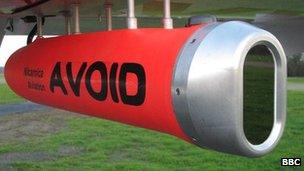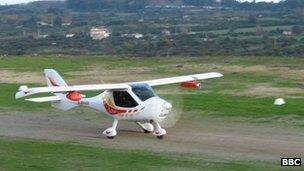Flying through volcanic ash clouds
- Published
The infrared system can work out ash cloud density
Imagine that the next time a volcano erupts in Iceland, the airlines are able to treat it as though it was no more than a simple weather hazard, like fog.
Scientists working on an ash cloud detection system believe that airlines will soon be able to do just that.
Volcanic ash and jet engines simply don't mix. The superheated particles turn to glass inside the engine and stop it dead.
So, those who manage the airspace above us go to great lengths to keep aircraft well away from the ash clouds that form during an eruption.
Eruption
We saw the results of that in May last year following the eruption of Iceland's Eyjafjallajokull volcano. The drifting ash led to the closure of much of Europe's airspace over the course of the week.
According to International Air Transport Association more than 10 million passengers were affected when more than 100,000 flights were cancelled.
It cost the airlines $1.7bn (£1.06bn).
Its hardly surprising then that they've been scrambling to find a way to minimise any disruption from the next eruption (and there will be a next eruption).

The Airborn Volcanic Object Imaging Detector may help airlines avoid ash clouds
Air corridors
Easyjet has been funding research by Dr Fred Prata from the Norwegian Institute for Air Research (NILU).
He's developed a device called AVOID (Airborne Volcanic Object Imaging Detector) which uses an infra-red camera to see how dense particular areas of ash are.
With an AVOID device fitted onto a plane, Dr Prata believes a pilot could see ash clouds between 100 and 300 kilometres ahead and at altitudes up to 50,000 feet.
The AVOID device can measure the density of the ash cloud too, finding air corridors between different layers of ash.
"This device can be used in a tactical sense to let the pilot see the hazard and fly safely around it," says Dr Prata.
Ash clumps
He adds that data from a network of planes equipped with AVOID could be combined with meteorological data from the SEVIRI satellite to create a map of where an ash cloud is going and what parts of it would be safe to fly through.
Easyjet's head of engineering, Ian Davies, is working closely with Dr Prata.
He said existing models of ash dispersal assume that its evenly distributed throughout the atmosphere but their research shows that it actually "travels in clumps".
AVOID would let pilots "see those clumps and avoid those clumps," said Mr Davies.
If this technology had been available last year "most of…the airspace that we saw closed during the last two eruptions would never have been closed".
Volcanic testing

So far the device has only been tested on smaller aircraft
Dr Prata and his team have put an AVOID unit under the wing of a microlight aircraft which they have been flying over Europe's most active volcano, Mt Etna in Sicily.
They've taken the aircraft up to 12,000 feet and are now in talks with Airbus to fit a specially built unit onto the wingtip of an A340 jet for high altitude tests early next year.
Easyjet expects to fit a unit onto one of its own passenger planes next summer and will make it available to all other airlines too.
And its not before time, as the authorities in Iceland warn of intense seismic activity at another volcano - Katla, which may suggest that another eruption is on the way.